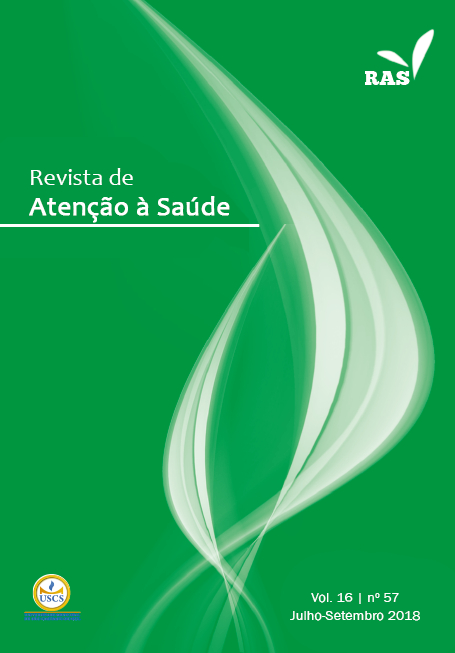O EFEITO DO TREINAMENTO DE ALTA INTENSIDADE NOS NÍVEIS GLICÊMICOS EM PESSOAS COM DIABETES MELLITUS TIPO 2
DOI:
https://doi.org/10.13037/ras.vol16n57.4161Keywords:
Treinamento de alta intensidade, Diabetes mellitus tipo 2, GlicemiaAbstract
Introdução: na atualidade, o diabetes mellitus tipo 2 tem sido considerado um dos principais problemas de saúde pública no Brasil. Objetivo: a presente pesquisa teve por objetivo buscar evidências na literatura científica sobre os efeitos do treinamento de alta intensidade (HIT) nos níveis de glicemia no sangue em pessoas com diabetes tipo 2. Método: foram consultadas as bases de dados PUBMED e EBSCO, utilizando-se os termos “high intensity training”, “diabetes type 2” e “glycemia”. Resultados: oito estudos foram selecionados para análise dos resultados. Os estudos abordaram o efeito de diferentes tipos de treinamentos baseados em alta intensidade na glicemia sanguínea. Conclusão: os resultados dos estudos evidenciaram efeitos positivos nos níveis de glicemia no sangue em pessoas com diabetes tipo 2. Embora não tenha sido objeto de estudo, foram encontradas evidências de que o HIT trouxe benefícios na aptidão física e funções fisiológicas dos indivíduos analisados.
Downloads
References
(1) Zajdenverg L. Tipos de diabetes. São Paulo: Sociedade Brasileira de Diabetes. [acesso em: 01 set. 2015]. Disponível em: <http://www.diabetes.org.br/para-o-publico/diabetes/tipos-de-diabetes>.
(2) SBEM (Sociedade Brasileira de Endocrinologia e Metabologia). O que é Diabetes? [acesso em: 01 set. 2015]. Disponível em: <http://www.endocrino.org.br/o-que-e-diabetes/>.
(3) Oliveira JEP, Vencio S. Diretrizes da Sociedade Brasileira de Diabetes 2014-2015/Sociedade Brasileira de Diabetes. São Paulo: AC Farmacêutica; 2015.
(4) Laursen P, Jenkins D. The scientific basis for high-intensity interval training. Optimising training programmes and maximising performance in highly trained endurance athletes. Sports Med, 2002; 32(1): 53-73.
(5) Gibala MJ, McGee SL. Metabolic adaptations to short-term high-intensity interval training: A little pain for a lot of gain? Exerc. Sports Sci. Rev., 2008; 36(2): 58-63.
(6) Gillen JB, Little JP, Punthakee Z, Tarnopolski MA, Riddell MC, Gibara MJ. Acute high-intensity interval exercise reduces the postprandial glucose response and prevalence of hyperglycaemia in patients with type 2 diabetes. Diabetes, Obesity and Metabolism, 2012; 14(6): 575-577.
(7) Balducci S, Zanuso S, Cardelli P, Salvi L, Bazuro A, Pugliese L, Maccora C, Iacobini C, Conti FG, Nicolucci A, Pugliese G. Effect of high- versus low-intensity supervised aerobic and resistance training on modifiable cardiovascular risk factors in type 2 diabetes; The Italian Diabetes and Exercise Study (IDES). PLoS ONE, 2012; 7(11): e49297.
(8) Terada T, Friesen A, Chahal BJ, Bell GJ, McCargar LJ, Boulé NG. Exploring the variability in acute glycemic responses to exercise in type 2 diabetes. Journal of Diabetes Research, 2013; ID 591574.
(9) Madsen SM, Thorup AC, Kristian O, Jeppesen PB. High intensity interval training improves glycaemic control and pancreatic β cell function of type 2 diabetes patients. PLoS ONE, 2015; 10(8): e0133286.
(10) Little JP, Gillen JB, Percival ME, Safdar A, Tarnopolski, MA, Punthakee Z, Jung ME, Gibala MJ. Low-volume high-intensity interval training reduces hyperglycemia and increases muscle mitochondrial capacity in patients with type 2 diabetes. J Appl Physiol, 2011; 111(6): 1554-1560.
(11) Dunstan DW, Daly RM, Owen N, Jolley D, Courten M, Shaw J, Zimmet J. High-intensity resistance training improves glycemic control in older patients with type 2 diabetes. Diabetes Care, 2002; 25(10): 1729-1736.
(12) Taylor JD, Fletcher JP, Mathis RA, Cade WT. Effects of moderate- versus high-intensity exercise training on physical fitness and physical function in people with type 2 diabetes: a randomized clinical trial. Physical Therapy, 2014; 94(12): 1720-1730.
(13) Karstoft K, Winding K, Knodsen SH, Nielsen JS, Thomsen C, Pedersen BK, Solomon TPJ. The effects of free-living interval-walking training on glycemic control, body composition, and physical fitness in type 2 diabetic patients. Diabetes Care, 2013; 36(2): 228-236.
Downloads
Published
Issue
Section
License
Policy Proposal for Journals offering Free Delayed Access
Authors who publish in this magazine agree to the following terms:
- Authors maintain the copyright and grant the journal the right to the first publication, with the work simultaneously licensed under a Creative Commons Attribution License after publication, allowing the sharing of the work with recognition of the authorship of the work and initial publication in this journal.
- Authors are authorized to assume additional contracts separately, for non-exclusive distribution of the version of the work published in this magazine (eg, publishing in institutional repository or as a book chapter), with the acknowledgment of the authorship and initial publication in this journal.
- Authors are allowed and encouraged to publish and distribute their work online (eg in institutional repositories or on their personal page) at any point before or during the editorial process, as this can generate productive changes, as well as increase impact and citation of the published work (See The Effect of Open Access).









